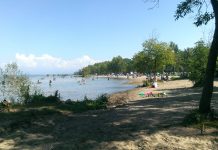24 November 2014, – Toronto – Canadian Cancer Society: 96% of Canadians have not tested their homes for radon gas, a recent survey commissioned by the Canadian Cancer Society shows. Yet 51% of Canadians said they would move if they were aware that there was radon in their home.
Exposure to radon gas increases your risk of lung cancer. It is estimated that 3,000 Canadians die every year from lung cancer caused by radon.
November is Radon Action Month, and the Society urges all Canadians to be aware of the cancer risk posed by radon and to test their homes.
“Many people think that smoking is the only cause of lung cancer, but in fact about 16% of lung cancer deaths are caused by radon exposure, making it the second-leading cause of lung cancer after tobacco,” says Robert Nuttall, Assistant Director, Cancer Control Policy, Canadian Cancer Society. “Testing your house for radon is the only way to know if you are at risk.”
Radon is a colourless, odourless, tasteless radioactive gas found naturally in the environment that can seep in through cracks and crevices in houses and other enclosed spaces.
To test for radon, you can purchase a relatively inexpensive test kit at your local hardware store or hire a professional to perform a test for you. The age of your home or radon levels in other houses and buildings in your neighborhood are not good indicators of how high radon levels will be in your home.
Janet Whitehead, a lung cancer survivor and radon activist, knows first-hand the power of a radon test. Janet has never smoked, but when she was diagnosed with lung cancer, she decided to send radon tests to the 2 homes in Ottawa where she had lived for years before moving to BC. One of the homes tested a staggering 16 times above the Health Canada radon guideline of 200 Bq/m3 (bequerels per cubic metre, a measure of radioactivity). “The good news is that the home has now been successfully mitigated for radon and is completely safe for the current homeowner and family,” says Janet. “I encourage all Canadians to test their homes for radon. Taking action now may save you from a lung cancer diagnosis 20 years down the road.”
If the levels of radon in your home are higher than 200 Bq/m3, you should hire a certified radon professional to determine the best and most cost-effective way to reduce these levels. The Society provides information about ways to reduce your risk and offers links to more information about radon.
How radon gets in
Radon is released into the air as soil and rocks containing uranium naturally break down. Outdoors, the released radon is quickly dispersed and levels remain very low. However, when radon enters buildings through foundations, joints and vents, it can accumulate to higher concentrations. This is particularly true in basements, which are often poorly ventilated. High concentrations of radon may increase lung cancer risk, and Health Canada recommends that homes with radon concentrations of 200 Bq/m3 or higher should be remediated to lower the levels of radon.
How you can test for radon
A radon testing kit can be purchased from your local hardware store and also online through some organizations. The kit should be placed in the home for 3 to 6 months during the time of year when most windows and doors are closed (fall and winter). The kit must be sent to a lab to receive the test results. The lab submission cost is included in most kits. The Society offers a list of resources to help you find out where to buy a radon test kit or contact a certified radon professional.
How radon causes lung cancer
Radon is a radioactive gas, meaning that it naturally decays into smaller particles over time. We breathe these particles into our lungs, where they can break down even further. This process releases small bursts of energy that can damage the cells in our lungs, which can sometimes lead to lung cancer.
The risk of developing lung cancer depends on how much radon a person is exposed to, how long they are exposed as well as whether or not they smoke. The risk from radon is much higher in people who smoke than in those who don’t.
Lung cancer facts
In 2014, an estimated 26,100 Canadians will be diagnosed with lung cancer, and 20,500 will die of the disease. It is estimated that about 3,000 lung cancer deaths each year are related to radon.
Lung cancer remains the leading cause of cancer death for both men and women and takes the lives of more Canadians than breast, prostate and colorectal cancers combined.
About the survey
The survey was conducted online by Angus Reid, from October 22–29, 2014, among a randomly selected sample of 1,238 Canadians aged 18+. The margin of error for a sample this size is +/-2.8%, 19 times out of 20.
About the Canadian Cancer Society
The Canadian Cancer Society is a national, community-based organization of volunteers whose mission is the eradication of cancer and the enhancement of the quality of life of people living with cancer. Thanks to our donors and volunteers, the Society has the most impact, against the most cancers, in the most communities in Canada. Building on the progress we have made, together with Canadians we are working to change cancer forever. For more information, visit cancer.ca or call our toll-free, bilingual Cancer Information Service at 1-888-939-3333 (TTY 1-866-786-3934).
Source: http://www.cancer.ca/en/about-us/for-media/media-releases/national/2014/radon-survey/?region=on#ixzz3K11xLAka

















